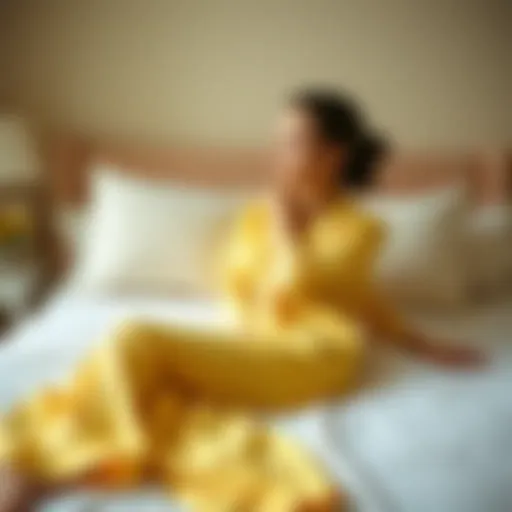Enhance Your Outdoors with Hanging Suncatchers


Intro
Outdoor hanging suncatchers have become a popular element in many gardens and outdoor spaces, transforming ordinary areas into vibrant displays of color and light. These decorative pieces not only enhance the aesthetic appeal of a space but can also fulfill functional needs, such as providing gentle illumination or creating a whimsical atmosphere. For those looking to spruce up their outdoor environment, understanding the diverse options available and how to best implement them is paramount.
From various designs and materials to placement strategies, the world of suncatchers offers a wealth of inspiration. Their ability to catch the sunlight and create fleeting, prismatic effects can change the feel of a garden, patio, or balcony completely. This exploration aims to provide practical insights into how to choose and maintain suncatchers, thus helping readers make informed decisions regardless if they are aiming for personal enjoyment or commercial projects.
As we delve deeper into the article, we will explore several dimensions of outdoor hanging suncatchers, including the latest trends, style tips, and practical considerations. Each aspect ensures that these aesthetic pieces integrate beautifully into the spaces they occupy, inviting both beauty and functionality.
"A well-placed suncatcher not only draws the eye but can also serve as a focal point, elevating the character of any outdoor setting."
The upcoming sections will guide readers through the essentials of selecting suncatchers suited to their unique styles and needs.
Understanding Outdoor Hanging Suncatchers
Outdoor hanging suncatchers serve more than just ornamental purposes; they tantalize the senses and can even enliven dull spaces. These decorative items are an intersection of art and functionality. By capturing sunlight and casting dancing patterns across surfaces, they play a role in enhancing the visual appeal of gardens, porches, and public spaces alike. It’s important to understand how these elements contribute to both aesthetic charm and practical benefits.
Importance in Design
Suncatchers can transform an ordinary outdoor space into a visual feast. Their shimmering colors alter the ambiance, providing a breath of fresh air to environments that may otherwise lack vitality. Whether it's a cozy backyard retreat or an expansive public garden, the right suncatcher can serve as a focal point, pulling the eye and enhancing the overall design. Not only do they beautify, but they can also denote spaces, guiding people towards quiet corners or play areas.
Considerations for Use
While contemplating the inclusion of hanging suncatchers, it's beneficial to weigh several considerations to maximize their flair and functionality. Here are some critical aspects:
- Placement: The right lighting is crucial. Suncatchers need direct sunlight to showcase their true essence.
- Materials: Different materials respond uniquely to light, significantly influencing the colors cast onto surrounding spaces. Choosing materials that withstand weather conditions is essential to longevity.
- Scale: Suncatchers come in various sizes; larger pieces can make bold statements, while smaller ones can be tucked into nooks.
By recognizing these elements, one can better appreciate how outdoor hanging suncatchers contribute to the aesthetic and functional aspects of outdoor spaces, paving the way for informed decisions when incorporating them into personal or commercial settings.
Definition and Origins
The term "suncatcher" typically refers to decorative elements crafted to capture and refract sunlight, displaying vibrant colors through glass or resin. Their origins trace back to various cultures harnessing the beauty of light. The intersections of art and nature create a captivating narrative. In many cultures, including Native American and Celtic traditions, these objects were often imbued with spiritual significance, believed to bring good fortune and ward off negative energies. As craftsmanship has evolved over the years, so too has the concept of suncatchers, morphing into a popular decorative fixture in contemporary outdoor settings.
Cultural Significance
Throughout history, outdoor hanging suncatchers have held various meanings across different cultures. For instance, in Eastern traditions, they symbolize the connection between earthly realms and spiritual domains. The colors thrown by the glass are thought to represent the energies of nature, reinforcing a sense of harmony. In more modern contexts, they are often embraced for their aesthetic appeal and ability to create serene atmospheres.
Moreover, in the realm of art, they symbolize the fusion of creativity and the natural world. Artists have increasingly turned to sustainable materials to craft suncatchers, allowing for a deeper connection to eco-friendly practices. The rise of DIY suncatcher projects also reflects cultural trends towards personalization and individuality within home decor, showcasing trends where custom designs create personal narratives.
"Every suncatcher tells a unique story, illuminating spaces and revealing the intricate relationship between light and art."
In summary, understanding the definition and cultural significance of outdoor hanging suncatchers roots this decorative element in a rich history while showcasing its evolving role and relevance in today's artistry and design.
Material Choices for Suncatchers
Choosing the right materials for outdoor hanging suncatchers is crucial, not just from an aesthetic standpoint, but also for functionality and durability. Suncatchers are often exposed to various weather conditions and need to withstand the elements while providing a beautiful visual display. Various materials offer unique characteristics that cater to different tastes and requirements. Understanding these can help in making informed decisions that enhance the overall appearance and longevity of your suncatcher setups.
Glass Suncatchers
Types of Glass
When we talk about glass suncatchers, the types of glass used can make a world of difference. There’s a multitude of glass varieties available, ranging from colored stained glass to crystal. Each type can affect the way sunlight refracts, thus determining how the colors play out in your garden or patio. Stained glass, for instance, is well-known for its ability to create vibrant hues when the sun shines through it.
A significant characteristic of stained glass is its ability to absorb and filter light, thus casting a warm glow that enchants the surrounding area. This type brings a classiness that’s hard to replicate. On the downside, glass can be fragile; it’s imperative to be cautious regarding placement to prevent breakage from falling debris or during harsh weather. However, despite its fragility, many still choose it for its timeless beauty.
Crafting Techniques
Crafting techniques play another pivotal role in the appeal and function of glass suncatchers. Techniques like fusing, slumping or even mosaic design can create unique forms. Fusing glass involves heating different glass pieces together until they melt slightly, creating seamless designs.
The uniqueness here lies in how different colors merge, causing blends that are just as beautiful as the sun’s rays that interact with them. While these methods require expertise, the outcome tends to be highly rewarding in visual appeal. Other methods are simpler, allowing novices to create beautiful decor quickly, even if they can’t match the intricacy of professional works.
Acrylic and Plastic Alternatives
Durability and Colors
When looking for more practical solutions, acrylic and other plastics present a compelling alternative. The resilience of acrylic in outdoor settings cannot be understated. Unlike glass, acrylic is shatter-resistant, which gives peace of mind when installed in bustling environments or with children around.
Moreover, these materials come in a cornucopia of colors, making it easy to match any design scheme. The impact resistance of acrylic often leads to a longer lifespan than its glass counterparts. That said, acrylic may not possess the same lush depth of color as glass, which some purists may find unappealing. Nonetheless, their practical benefits make them an excellent choice for those who value durability and versatility over traditional aesthetics.
Advantages Over Glass
One fundamental advantage of acrylic and plastic suncatchers over glass ones has to do with weight. Lighter materials can be easier to install and reposition when desired. This flexibility is beneficial for those who frequently change their outdoor configurations or want to maintain dynamic decor. Moreover, the cost-effectiveness of acrylic cannot be overlooked. Generally, plastic alternatives tend to be less expensive than glass, providing a budget-friendly option without skimping too much on visual splendor.
It is worth noting, however, that plastic might fade due to prolonged sun exposure compared to glass. So even though the initial costs are lower, the potential need for replacement may balance that out over time.


Natural Materials
Wooden Suncatchers
Wooden suncatchers can infuse a unique earthy flair into your outdoor living spaces. Not having the same fragility associated with glass, wood can endure more rugged environments. The organic look can complement natural surroundings beautifully, offering a connection to nature. Moreover, wood can be finished in various ways—a clear coat for a natural appearance or colorful paints to suit your personal taste.
One key characteristic of wooden designs is their customization potential; creative souls can easily carve or paint them to produce one-of-a-kind pieces. On the flip side, wooden suncatchers require regular maintenance like sealing or treating to keep weather-related deterioration at bay. With good care though, these beautiful pieces can last for years.
Stone Elements
Stone elements add a different dimension to the world of suncatchers, bringing solidity and a rustic feel. Common choices include slate or other natural stones, which can artfully be combined with hanging components to create stunning contrasts. They can withstand the elements remarkably well, providing longevity in any outdoor setting.
The characteristic weight of stone can serve a functional purpose by adding stability to your hanging decor, preventing it from blowing away during strong winds. However, the challenge lies in their installation; heavier materials can require more secure anchoring methods, which may complicate the setup. Despite this, their timeless appeal and durability make stone a favored choice among those seeking something beyond the ordinary.
"In the end, the material you choose for your suncatcher will significantly affect both its aesthetic appeal and its practicality, so weigh your options carefully."
Design Variations in Outdoor Suncatchers
The world of outdoor hanging suncatchers is as expansive as it is colorful. Design variations in suncatchers not only contribute to their visual appeal but also serve as a reflection of personal taste and aesthetic choices. By diversifying design elements, creators can tailor these decorative pieces to fit specific environments and purposes, enhancing gardens, patios, or even urban spaces. This section will explore the importance of various design styles, enriching the reader’s understanding of how these variations play a pivotal role in suncatcher implementation.
Traditional Designs
Traditional designs draw heavily from cultural roots and historical motifs. These suncatchers often feature intricate patterns or designs that have been passed down through generations, connecting the artist with centuries of artistic heritage. For instance, you might find suncatchers adorned with floral patterns, mandalas, or symbolic shapes like the sun and moon. These designs not only evoke a sense of nostalgia but also blend seamlessly with natural settings, making them a fitting choice for outdoor spaces. The craftsmanship involved in traditional designs often showcases manual techniques, offering a tactile quality that speaks to the value of artistry in nature.
Modern and Minimalist Styles
Contemporary aesthetics in outdoor suncatchers lean towards simplicity and functionality, often focusing on sleek designs that prioritize form and color over intricate embellishments.
Geometric Shapes
Geometric shapes represent one key characteristic of modern and minimalist styles. These suncatchers often utilize fundamental forms—triangles, circles, and squares—that create a harmonious visual impact. The contribution of geometric shapes to the overall aesthetic lies in their ability to bring a sense of order and structure amid organic environments. Such forms can strategically echo architectural elements in nearby structures, tying the entire space together.
One unique feature of geometric shapes is their versatility, fitting into both contemporary and traditional settings when crafted thoughtfully. However, a downside could be that some might find the simplicity lacking depth, relying heavily on color and placement to do the heavy lifting in terms of visual appeal.
Color Blocking
Color blocking is another element that stands out in modern suncatcher designs. This technique involves using solid blocks of color in contrasts, creating bold visual statements. The key characteristic of color blocking is its potential for making suncatchers pop against various backgrounds, captivating the eye and engaging viewers in an immediate emotional response. It’s a style that lends itself well to a playful, vibrant atmosphere, often found in gardens and patios adorned with lively florals.
A unique advantage of color blocking is the ease of customization; individuals can select colors that resonate with their surroundings to achieve a desired mood. However, it might detract from some traditional aesthetics that appreciate fluidity and intricate designs, making it a choice better suited for modern tastes.
Custom and Artistic Designs
The rise of personalized art has an undeniable influence on the market for outdoor suncatchers. Custom and artistic designs allow individuals to express their unique preferences and creativity, setting their space apart from the mundane.
Mixed Media Approaches
Mixed media approaches mix various materials, incorporating glass, wood, and metal, creating intriguing textures and layers. This infusion of materials adds depth and an artisanal quality to suncatchers, making them standout features in any outdoor setting. By leveraging diverse media, artists can merge visual appeal with tactile experiences, keeping the viewer engaged on multiple levels. One big benefit is the opportunity for innovation; artists can continuously experiment with different combinations to keep designs fresh.
However, managing the durability of the materials can present a challenge, especially outdoors where weather conditions vary. This necessitates careful selection and treatment of materials to ensure longevity.
Personalized Suncatchers
Personalized suncatchers offer a unique opportunity for individuals to imprint their identity onto an integral outdoor element. This could range from custom designs that feature names, dates, or even significant symbols. The advantage here is that it fosters a deeper connection to the piece itself, turning a decorative item into a cherished keepsake.
One must approach personalized designs with thoughtfulness, as they can be more challenging to create and may require specific crafting skills or services. Additionally, while they are visually compelling, they could limit versatility in placement or aesthetic coherence with larger design themes.
Installation Techniques
Installation techniques are crucial when it comes to outdoor hanging suncatchers. The manner in which a suncatcher is installed can significantly impact its function and aesthetics, turning a simple decorative piece into a focal point of the outdoor space. Not only do proper installation methods ensure longevity, but they also enhance the visual appeal and effectiveness of the suncatcher in capturing sunlight.
Choosing the Right Location
Sunlight Exposure
One of the most vital factors in choosing the right location for your suncatcher is sunlight exposure. This aspect determines how well a suncatcher will perform in its role of creating beautiful reflections and rainbow effects. Hang it where sunlight filters in most effectively, perhaps near a south-facing window or in a garden that receives direct sunlight for a greater part of the day.
The key characteristic that makes sunlight exposure so beneficial is its direct influence on the vibrancy of the colors within the suncatcher. When light strikes the glass, it fractures and refracts, creating a captivating display of colors. Moreover, adequate exposure enhances the interaction between light and the decorative piece, allowing it to contribute significantly to the ambiance.
However, one must consider that too much intense sunlight can fade colors over time or even cause some materials to warp. Thus, balance is important. Positioning the suncatcher strategically to manage the exposure can lead to optimal performance without compromising its integrity.


Visibility and Aesthetics
Equally important is the visual aspect of placement, encapsulated in the concept of visibility and aesthetics. A suncatcher should not only be functional but also a delight to behold. Choosing a location that enhances its visibility ensures its beauty is appreciated from various angles.
The characteristic that stands out here is how visibility can transform a suncatcher into a statement piece. When placed in a high-traffic area or a space where sitters can admire it, it becomes a conversation starter. Additionally, arranging suncatchers alongside other plants or decorative elements enhances the overall aesthetic composition of the space.
Yet, while it’s beautiful to see your suncatcher from afar, too much clutter around it may detract from its emphasis. Therefore, a select and thoughtful placement can make all the difference, creating a harmonious balance between visibility and the surrounding environment.
Hanging Methods
Hooks and Ropes
When it comes to hanging your suncatcher, hooks and ropes can make all the difference. These methods are generally the most straightforward, providing both stability and versatility in positioning. Secure hooks onto wall mounts, trees, or pergolas, allowing the suncatcher to dangle gracefully in the breeze.
What is beneficial about hooks and ropes is their adjustability. Depending on the length of the ropes, you can vary the height at which your suncatcher hangs. This allows for creativity; a cluster of suncatchers at different heights can create a dynamic visual effect. The accessibility of such hardware makes them an easy choice for many decorators.
One drawback, however, is that hooks need to be securely fastened to withstand elements like wind or rain. Weigh the attachments against different weather conditions to ensure longevity.
Weight Considerations
Weight considerations also play a fundamental role in installation. Understanding the weight of your suncatcher is essential when determining how and where to hang it. A heavier suncatcher may need a sturdier support system, such as robust hooks, while lighter ones can be suspended from thinner ropes.
The key characteristic of weight is that it impacts both functionality and safety. Ensuring that the medium used for hanging can support the weight prevents accidents that could lead to breakage or injuries. If successful, the suncatcher remains intact and continues to dazzle passersby.
However, if the weight exceeds what the installed support can handle, you might face risks of falling. Thus, understanding the balance of weight is paramount in providing a stable, long-lasting installation that contributes to the splendor of your outdoor space.
Creative Placement Ideas
The charm of outdoor hanging suncatchers extends beyond their aesthetic appeal; where you choose to place them can elevate their impact significantly. Creative placement ideas breathe life into your spaces, turning mundane corners into vibrant focal points. Think of strategy, visibility, and natural light—those elements marry together to enhance the effect of a suncatcher, making it not just a decorative piece but a stunning feature of your outdoor environment.
In Gardens
Among Plants
Suncatchers nestled among plants can create a magical ambiance, transforming gardens into whimsical retreats. This arrangement draws attention to both the suncatcher and the surrounding flora, creating a visual symphony. One key characteristic is how well the light refracts through the suncatcher, casting shimmering patterns that dance across leaves and petals.
The integration of glass or acrylic suncatchers with diverse plants offers a playful contrast; for example, a bright, multicolored suncatcher stands out amid lush green foliage, while more muted tones can create a serene vibe. This placement is beneficial because it harmonizes with nature, often resulting in a tranquil atmosphere.
However, a downside could be the challenge of maintenance, as dirt or leaves may accumulate on the suncatchers, necessitating regular cleaning to maintain their brilliance. Regardless, this thoughtful integration with nature typically pays dividends in charm and aesthetic pleasure.
Near Water Features
Positioning suncatchers near water features adds layers of complexity and beauty. When sunlight hits these glass creations close to a pond or fountain, the effect can be breathtaking. Water allows light to ripple, frequently amplifying colors and patterns cast by the suncatcher, forming a mini light show that can captivate anyone’s gaze.
This placement is particularly popular because it enhances the tranquil sound of flowing water by introducing visual movement and color. A soft breeze might even cause the suncatcher to sway gently, creating that enchanted, interactive element. Yet, it’s essential to consider water splashes, which can lead to frequent cleaning needs. Still, the visual payoff often outweighs this minor inconvenience, making it a delightful choice for those seeking to enliven their outdoor spaces.
On Patios and Porches
The allure of suncatchers on patios and porches cannot be overstated. These areas often serve as the bridge between inside and outside, and hanging a suncatcher here can artfully bring that outdoor magic closer. The primary advantage of placing suncatchers in these spots is the increased exposure to sunlight, allowing the glass to engage with the natural light brilliantly all day.
Additionally, patios and porches often function as gathering spaces. Guests and families can enjoy the aesthetic delights of these hanging decorations, further enhancing the communal experience. One drawback might be the potential for wind to knock the suncatchers off balance or cause wear and tear over time, but proper hanging methods can mitigate these risks.
In Urban Spaces
Urban living often challenges people to find a slice of nature amidst the concrete jungle, a challenge easily met by strategically placing suncatchers.
Balconies
Balconies present a unique opportunity for urban dwellers to implement suncatchers. Their elevated position generally allows them to capture maximum sunlight, creating a dazzling display of color against the often gray backdrop of city life. Furthermore, the vertical space of balconies lends itself to creative arrangements, using height to maximize impact.
While suncatchers can greatly enhance the visual appeal of a balcony, they often face exposure to harsh winds. However, this drawback can be overcome by opting for more durable materials or suitably weighing them down for stability. Ultimately, balconies can become vibrant urban escapes when adorned with the right hanging suncatchers.
Community Gardens
Community gardens are treasure-troves of sustainability and local engagement. Hanging suncatchers can signify unity and creativity in these shared spaces. The placement of these colorful accessories can also attract people’s attention, allowing for conversations about gardening, community efforts, and art.
What sets community gardens apart is the shared interest in nature, so adding a personal touch through suncatchers can foster community spirit and personal connection. Although the potential wear from natural elements cannot be ignored, the sense of creativity and shared ownership often outweighs these concerns. This makes community gardens an uplifting choice for placing outdoor hanging suncatchers.
Embracing creative placement ideas for suncatchers in a variety of environments ultimately enhances not just the aesthetic appeal, but also the emotional atmosphere of outdoor living spaces.


Maintenance of Outdoor Hanging Suncatchers
Proper maintenance of outdoor hanging suncatchers not only prolongs their lifespan but also ensures that they continue to add beauty and charm to any outdoor space. These decorative elements face harsh environmental conditions such as rain, heat, and dust, which can diminish their vibrancy over time. Thus, understanding how to care for them is invaluable for anyone wanting to keep their suncatchers looking their best.
Cleaning Techniques
Regular cleaning is essential for maintaining the aesthetic appeal of suncatchers. It's surprising how dust and grime can obscure the light-play that makes them so special.
Safe Cleaning Agents
When it comes to cleaning agents, safety should be top of mind, especially for suncatchers made from glass or delicate materials. Many people prefer to use a gentle mixture of warm water and mild dish soap as a safe cleaning agent. This combination is effective without being harsh, ensuring that the colors and shine of the suncatchers last longer.
The key characteristic is that these agents won’t scratch or damage the surfaces. Instead of risking the integrity of the material with strong chemicals, going the gentle route proves to be a beneficial choice for those aiming to preserve their suncatchers' allure. Moreover, using natural cleaning solutions can be quite economical and easy on the environment, making it a popular option among eco-conscious consumers.
One unique feature is that natural cleaning agents can often remove grime without leaving harmful residues, ensuring a safer outdoor environment. Although effective, it is always wise to perform a patch test in an inconspicuous area to confirm compatibility with the material.
Frequency of Cleaning
Frequency of cleaning is another critical aspect when discussing suncatcher maintenance. Ideally, suncatchers should be cleaned every few months, depending largely on environmental factors like local pollution levels and weather conditions. If you're situated in a windy or dusty area, you might consider cleaning them more often.
The key characteristic of this regular routine is that it prevents buildup, allowing the light to pass through more effectively. It’s a practical approach that not only maintains visual appeal but also makes the cleaning process easier each time, preventing layers of dirt from accumulating.
Cleaning them consistently can also help identify any potential damage sooner, allowing for prompt repair, which is a beneficial practice in maintaining their condition.
Weatherproofing Tips
Weatherproofing is another crucial aspect of maintaining outdoor hanging suncatchers. This ensures they can withstand the elements, be it the scorching sun or the unexpected rain.
Material Durability
Material durability plays a significant role in how well suncatchers hold up against various weather conditions. For instance, glass suncatchers are breathtaking but can be susceptible to shattering when exposed to temperature changes. On the flip side, acrylic or specialized plastic alternatives are often more durable. They tend to resist impact and don’t break as easily as glass, making them a beneficial option for those often facing harsh weather.
Moreover, opting for durable materials also results in less replacement over time, which is a win-win for both aesthetics and budget. A major unique feature of using durable materials is that they provide a long-lasting solution, meaning less maintenance and more time spent enjoying their beauty.
Protective Coatings
Investing in protective coatings can significantly enhance the longevity of suncatchers. These coatings act like a shield against UV rays, preventing colors from fading and materials from deteriorating. The key characteristic of protective coatings is their ability to repel grime and moisture, making cleaning easier and maintaining a fresh look for longer.
Choosing protective coatings is a popular decision among those who want to extend the life of their investments. However, one unique feature is that not all coatings are created equal. It’s advisable to research and select high-quality options that are tailored for outdoor use, as poor-quality coatings may wear off quickly, leading to unintended expenses in the long run.
The Environmental Impact of Suncatchers
When diving into the topic of outdoor hanging suncatchers, it's important to acknowledge their environmental influence. These decorative elements, while cherished for their aesthetic appeal, can also serve as a bridge to greater awareness regarding sustainability and eco-friendliness in outdoor decor. As many design aficionados and eco-conscious individuals look for ways to beautify their spaces without contributing to environmental degradation, understanding the impact of materials and manufacturing processes becomes paramount.
Sustainable Material Options
Selecting sustainable materials can make a significant difference in reducing the environmental footprint of suncatchers. Glass, acrylic, and natural materials like wood all have their unique roles. However, opting for eco-friendly versions of these materials—such as recycled glass or sustainably sourced wood—and ensuring that they are manufactured with minimal environmental impact is essential.
By looking for suncatchers made from sustainable sources, consumers not only enhance the visual appeal of their spaces but also support practices that limit resource depletion.
Reducing Carbon Footprint
Recycling in Design
Recycling in design offers a rich avenue for creativity while addressing waste. Integrating recycled elements into the crafting of suncatchers not only diverts materials from landfills but also promotes a circular economy. One appealing aspect is the potential for unique aesthetics, as recycled glass can display various textures and colors shaped by previous life experiences, which seem to tell stories of their own.
"Recycling transforms the ordinary into exquisite, catchy marvels that do more than look good—they do good."
Embracing recycling in suncatcher design is a beneficial approach. With the variety often found in recycled materials, each piece can possess a unique charm and character. Suncatchers crafted from these materials not only capture sunlight but also capture the imagination of onlookers, thus enriching both outdoor and indoor environments. On the downside, sourcing high-quality recycled materials can sometimes be a challenge, which may limit design possibilities.
Use of Natural Resources
Using natural resources taps into a vast repository of materials that are inherently linked to the ecosystem. Opting for responsibly sourced wood or natural stones can bolster the connection between nature and the suncatchers themselves. These materials often come with a smaller carbon footprint compared to synthetics. Furthermore, their organic textures and colors can seamlessly meld into garden or terrace aesthetics, bringing a touch of nature into everyday life.
Choosing to use natural resources for suncatchers comes with distinct advantages. They are generally biodegradable and can be less impactful on the environment throughout their lifecycle. As consumers become more discerning, the call for products that honor the Earth has become louder. Even so, being mindful of overharvesting is crucial—after all, it's essential to balance our creative pursuits with the conservation of our natural spaces.
Epilogue
In summarizing the essence of outdoor hanging suncatchers, it's crucial to recognize their dual role as both aesthetic enhancers and functional decor. These charming items don’t just beautify our outdoor spaces; they also serve practical purposes like reflecting light, creating ambiance, and even marking boundaries in gardens or patios. Integrating suncatchers into an outdoor design scheme can elevate the overall experience of a space, making it feel more engaging and lively.
Furthermore, the variety in materials and designs allows for personal expression. Whether one opts for vibrant glass pieces or eco-friendly natural elements, there are choices that suit every taste and setting. This adaptability is vital in the current trend where unique, personalized elements are highly valued in home and landscape design.
Consideration of installation techniques and proper placement can play a significant part in maximizing the visual impact of these hanging ornaments. Careful thought about sunlight exposure and visibility ensures that suncatchers fulfill their purpose effectively, transforming ordinary structures into stunning focal points.
Moreover, understanding maintenance needs helps preserve the investment made in these decorative pieces. Regular cleaning and weatherproofing will keep colors vibrant and materials intact, enhancing longevity.
Lastly, the environmental considerations involved in selecting sustainable materials resonate with a growing commitment to eco-friendly practices. This helps reduce the carbon footprint while enriching outdoor atmospheres with beauty.















